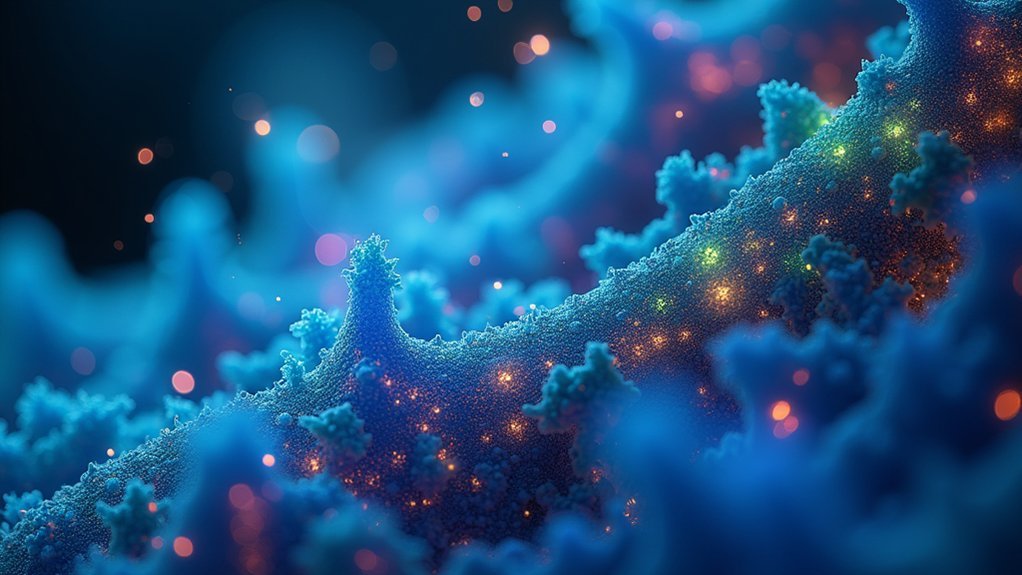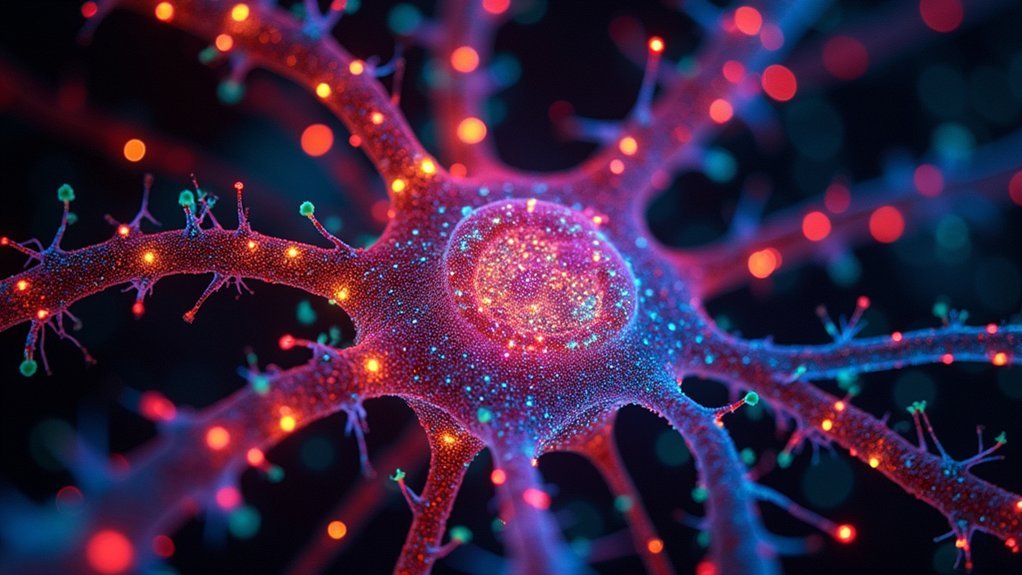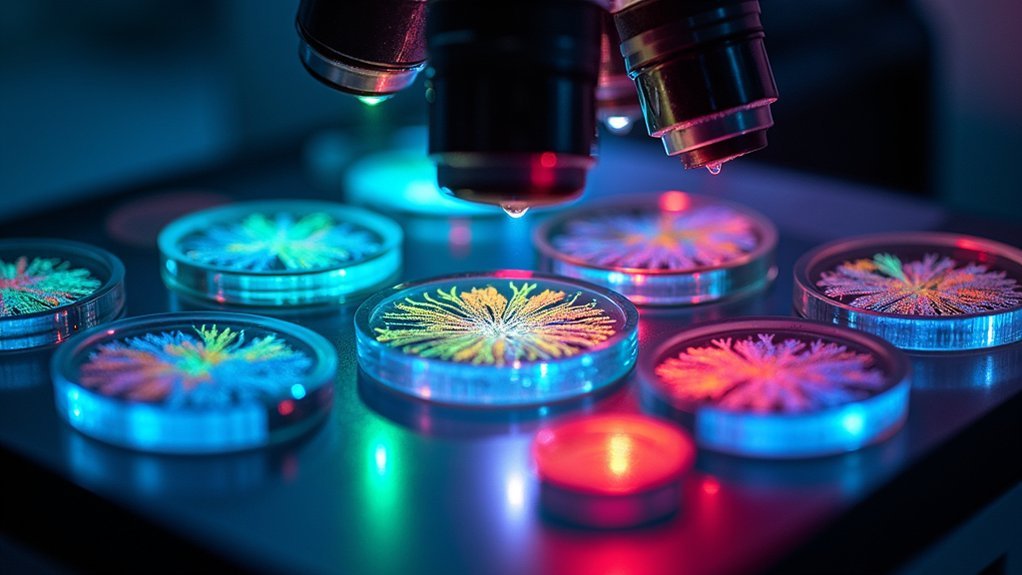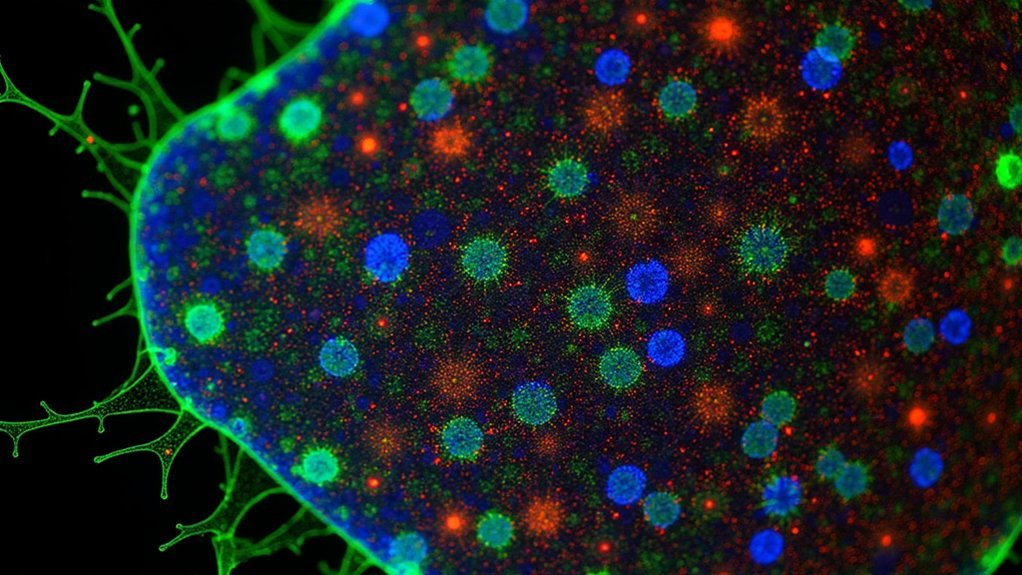The five most powerful two-photon fluorescence techniques you’ll want to evaluate are Multiphoton Lightfield Technology for volumetric imaging, Advanced Non-Descanned Detection Systems for improved sensitivity, Resonant Scanning for high-speed neural activity capture, Fluorescence Correlation Spectroscopy for molecular dynamics insights, and Fluorescence Lifetime Imaging Microscopy for distinguishing similar fluorophores. Each technique offers distinct advantages for live tissue imaging while minimizing photodamage. Explore how these cutting-edge approaches can revolutionize your research outcomes.
Multiphoton Lightfield Technology for Volumetric Imaging

While traditional microscopy techniques capture images one focal plane at a time, multiphoton lightfield microscopy (LFM) revolutionizes this approach by employing a microlens array at the back focal plane of the Fourier lens. This configuration enables parallel signal processing, greatly enhancing your imaging capabilities for complex biological samples.
You’ll experience considerably increased imaging speed with LFM compared to conventional laser scanning methods. By simultaneously capturing multiple focal points, two-photon excitation microscopy combined with lightfield technology reduces the time needed for volumetric imaging while maintaining excellent cellular resolution and signal-to-noise ratio.
The user-friendly interfaces available through platforms like napari make this advanced technology accessible for your research needs. These tools facilitate efficient 3D reconstruction, helping you visualize dynamic biological processes with unprecedented temporal resolution.
Advanced Non-Descanned Detection Systems
Because conventional detection methods often fail to capture scattered photons, advanced non-descanned detection systems represent a critical breakthrough in two-photon fluorescence microscopy.
The revolution in microscopy lies in capturing what was once lost—those elusive scattered photons conventional methods miss.
You’ll achieve up to three times higher sensitivity with these systems, which position multiple high-sensitivity detectors around the focal area to collect emitted fluorescence along the optical axis.
- Maximizes signal collection efficiency by capturing scattered photons that would otherwise be lost
- Considerably improves signal-to-noise ratio, especially in thick biological samples
- Integrates seamlessly with photomultiplier tubes to detect weak fluorescence signals
- Enables real-time observation of dynamic processes in live tissues
- Collects substantially more data per imaging session compared to traditional scanning methods
This technology is particularly valuable when you’re studying low-abundance targets, where capturing every photon matters for meaningful analysis.
Resonant Scanning for High-Speed Neural Activity Capture

When capturing the rapid communication between neurons, conventional scanning methods simply can’t keep pace with neural dynamics.
Resonant scanning transforms your two-photon fluorescence imaging capabilities with galvanometric mirrors operating at kHz rates, dramatically increasing acquisition speed while reducing photodamage.
You’ll achieve unprecedented temporal resolution—up to 198 Hz for calcium signals—allowing you to observe neural activity that would otherwise remain invisible.
By implementing adaptive sampling, you’ll focus only on active neurons, considerably enhancing your signal-to-noise ratio during high-speed imaging sessions.
Pairing resonant scanning with digital micromirror devices creates a powerful combination for dynamic beam shaping, enabling precise targeting of neural structures.
This technology simultaneously excites larger brain areas while depositing less total light energy into the tissue, preserving sample integrity during extended imaging experiments.
Fluorescence Correlation Spectroscopy (FCS) Integration
As researchers push beyond spatial resolution limits, Fluorescence Correlation Spectroscopy integration with two-photon microscopy offers unprecedented insights into molecular dynamics.
By parking your laser at specific locations, you’ll capture rapid intensity fluctuations that reveal essential molecular diffusion dynamics at the nanoscale. Two-photon excitation greatly enhances FCS capabilities by reducing background fluorescence and photodamage in live-cell studies.
Stationary laser positioning reveals nanoscale diffusion dynamics while two-photon excitation minimizes background noise and specimen damage.
- Analyze autocorrelation functions to extract diffusion coefficients and interaction parameters
- Determine concentration and oligomeric states of fluorescent molecules in living cells
- Assess kinetic properties with single-pixel intensity recording at millisecond timescales
- Benefit from reduced photodamage in deep tissue measurements
- Access thermodynamic properties of molecular interactions unavailable with conventional imaging
These integrated techniques now come in turn-key instruments, making them increasingly accessible for biological researchers investigating nanoscale molecular behavior.
Fluorescence Lifetime Imaging Microscopy (FLIM) Applications

Beyond analyzing molecular movement through FCS, Fluorescence Lifetime Imaging Microscopy offers a complementary dimension to two-photon microscopy that reveals molecular states invisible to conventional imaging.
FLIM measures the time-resolved decay of emitted light, allowing you to distinguish fluorophores with similar emission spectra but different lifetimes.
When integrated with two-photon excitation microscopy, FLIM delivers enhanced spatial resolution while minimizing photodamage and background fluorescence—critical advantages for live tissue imaging.
You’ll detect subtle molecular interactions and environmental changes like pH shifts or ion concentration fluctuations at the pixel level.
Though FLIM acquisitions require more time than standard intensity imaging, advanced photon collection techniques now optimize speed for dynamic biological processes.
The technique’s TCSPC approach creates precise photon timing histograms, providing quantitative data about molecular environments unattainable through conventional fluorescence measurements.
Frequently Asked Questions
What Is the Two-Photon Imaging Technique?
Two-photon imaging uses simultaneous absorption of two near-infrared photons to excite fluorophores in tissues. You’ll achieve deeper penetration and less photodamage while maintaining high resolution for in vivo biological imaging studies.
What Is the Two-Photon Induced Fluorescence Technique?
Two-photon induced fluorescence allows you to use near-infrared light to simultaneously excite fluorophores with two photons. You’ll achieve deeper tissue imaging with less photodamage and better spatial resolution than conventional microscopy techniques.
What Is the Two-Photon Approach?
The two-photon approach uses near-infrared light to simultaneously excite fluorophores with two lower-energy photons. You’ll get deeper tissue penetration, reduced photodamage, and better spatial resolution compared to conventional fluorescence microscopy techniques.
How Much Does a Two-Photon Microscope Cost?
You’ll find two-photon microscopes priced between $200,000 and $1 million. Basic models start around $200,000, while advanced systems exceed $1 million. Don’t forget to budget for accessories and maintenance costs too.
In Summary
You’ve explored the most cutting-edge two-photon fluorescence imaging methods available today. By incorporating these five advanced techniques into your research workflow, you’ll dramatically enhance your imaging capabilities and generate more thorough data. Whether you’re studying neural networks or cellular dynamics, these technologies offer unprecedented spatial resolution, imaging speed, and analytical depth. Don’t hesitate to combine these approaches for even more powerful experimental outcomes.





Leave a Reply